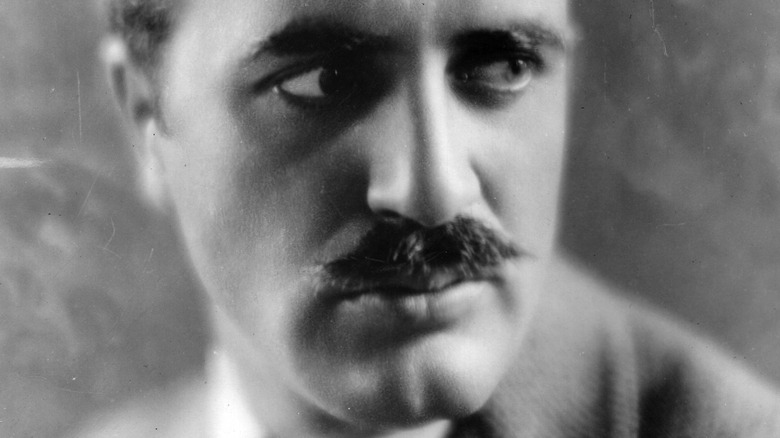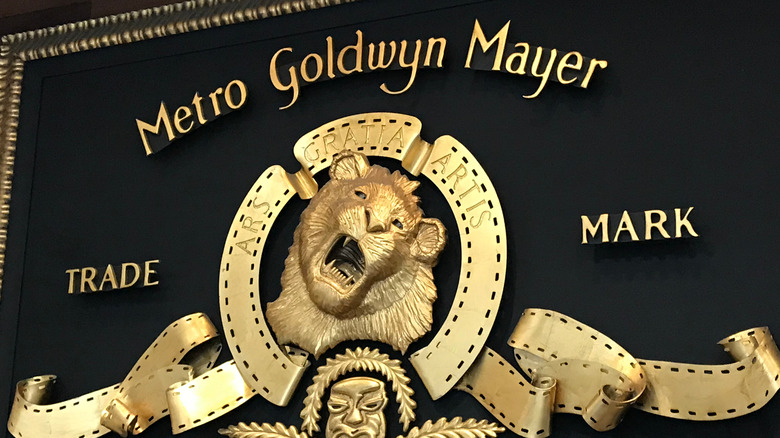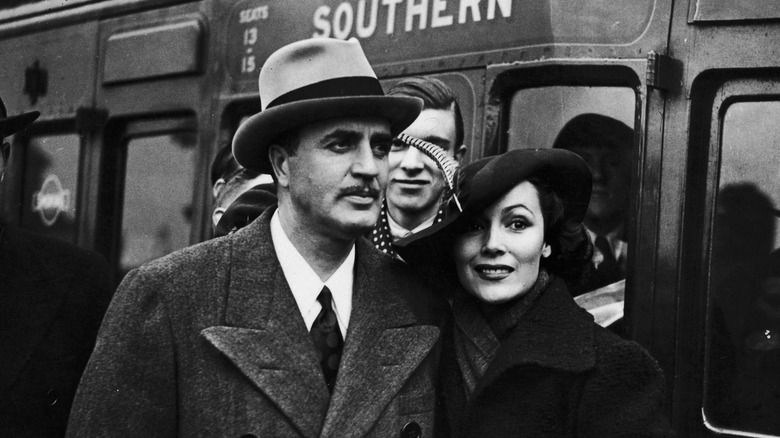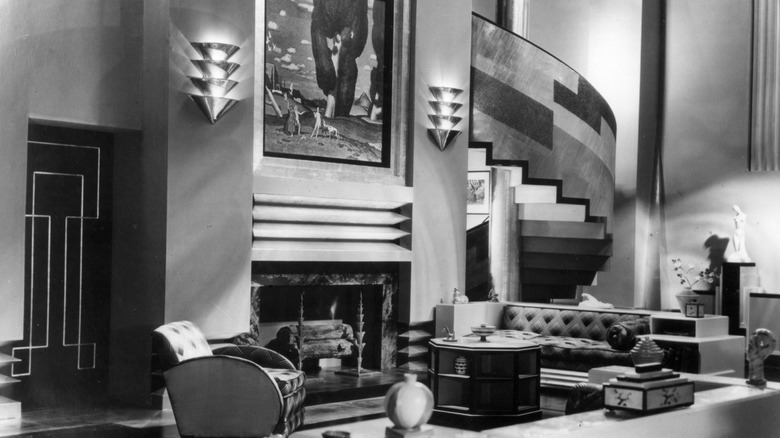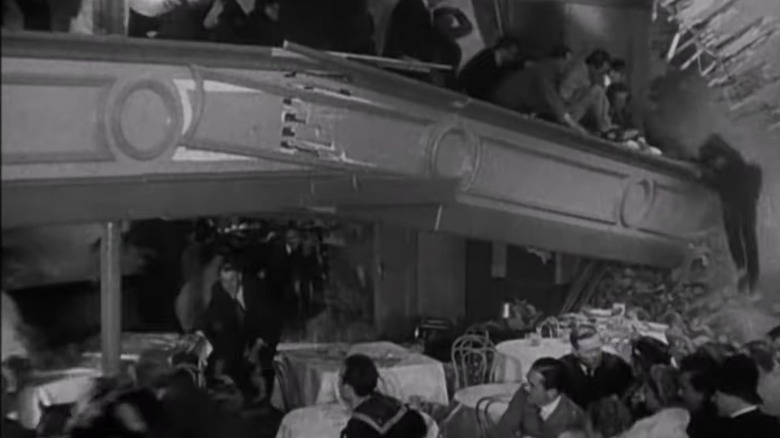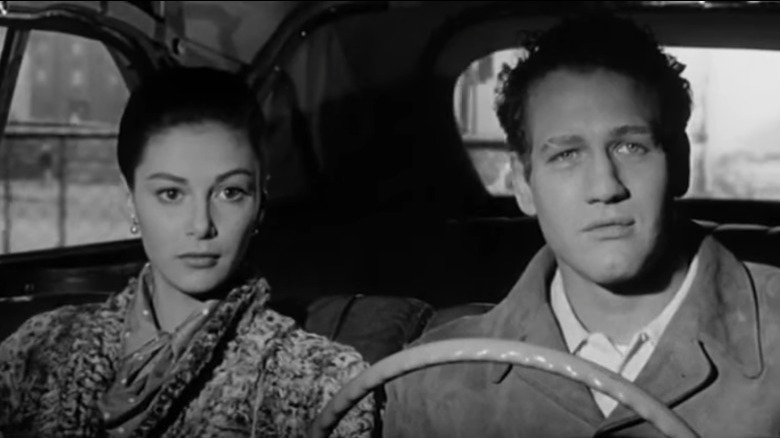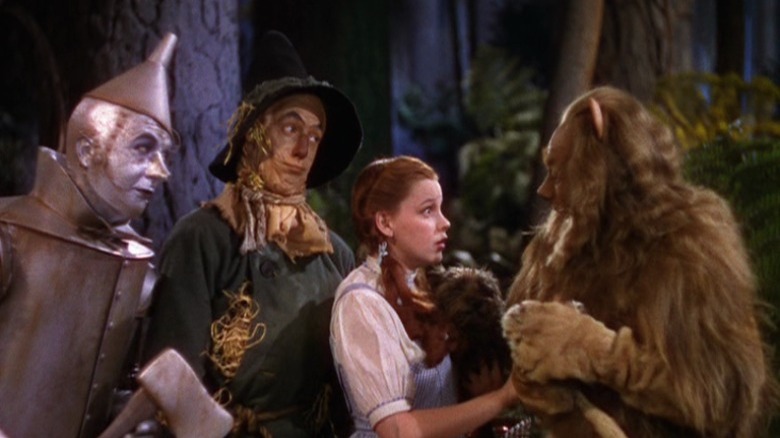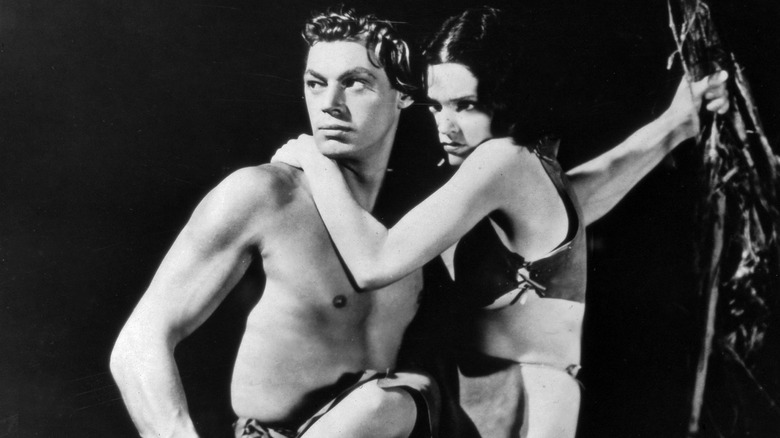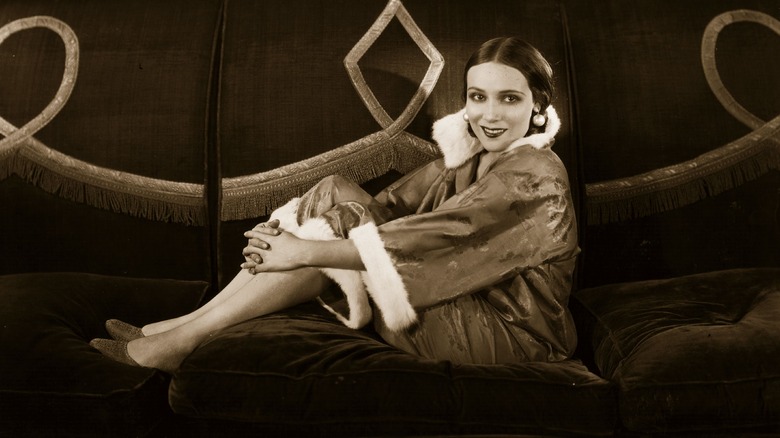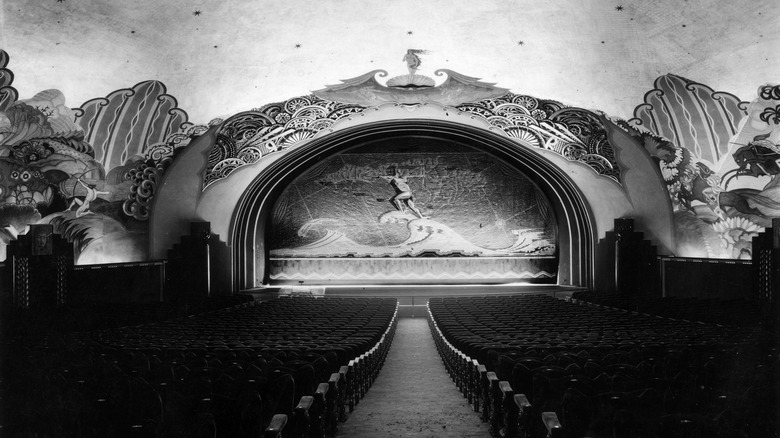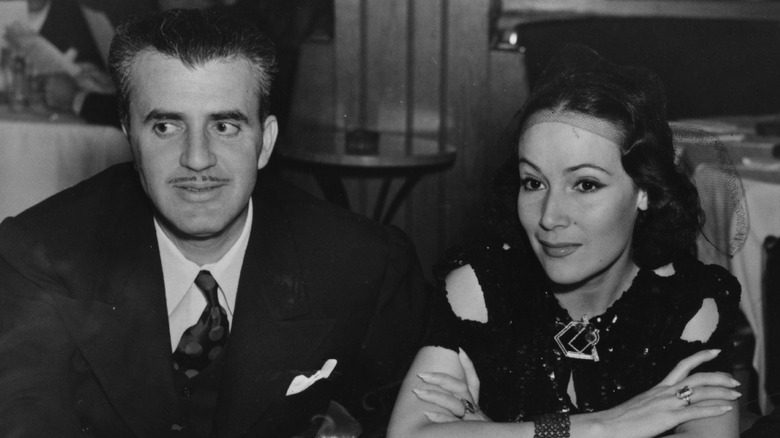The Untold Truth Of The Man Who Designed The Oscar Statuette (And Won 11 Of Them)
When Oscar season rolls around every year, it always brings with it a bunch of questions. You know, things like: Which Best Picture nominee will win the big prize? Why was the absolutely brilliant Movie A robbed of any nominations, while that piece of hot garbage Movie B pulled down 16 of them? And, how on Earth can anyone, no matter how famous, get away with wearing something like that ridiculous see-through dress in public?
Well, if you're anything like us, you may have often pondered a different question: Where did the actual Oscar statuette come from? Maybe you're a fan of bold, striking sculpture, or maybe you are Joaquin Phoenix, pondering the question as you stare at the well-deserved Oscar on your mantle. (Hi, Mr. Phoenix! Big fans.) In any event, if you want that story, you've come to the right place. The man responsible for the statuette's design isn't exactly a household name, unless you live in a household chock full of Hollywood set designers. He probably should be, though — because not only did he take home a wheelbarrow full of Oscars himself, but he's probably more responsible than any other one person for the way movies actually looked during Hollywood's Golden Age. Let's talk about the late, great Cedric Gibbons, Oscar designer, 11-time Oscar winner, and art director extraordinaire.
He was with MGM from the very beginning
Cedric Gibbons, who emigrated to America from Ireland with his family at the turn of the century, was trained as an architect like his father. Unlike his father, though, he lived in a world where motion pictures existed, and in 1915, the bright-eyed young man landed a job designing sets at Thomas Edison's film studio, according to the Irish Times. The gig didn't last too long, however — because Gibbons was so dope at his job that he was soon snatched up by the legendary Samuel Goldwyn, who appointed Gibbons lead art director of Goldwyn Studios at the tender age of 25.
A few years later, in 1924, that studio merged with Louis B. Mayer Pictures and Metro Pictures to become Metro-Goldwyn-Mayer, but you can just call it MGM for short. Gibbons retained his position at the new motion picture powerhouse, and he would keep it for over three decades. In fact, it was a stipulation of his contract that he be credited as lead designer on every single one of MGM's movies — a clause which allowed him to rack up a mind-blowing 1,500 credits over the course of his career.
He was a founding member of the Academy
By 1927, motion pictures were moving past their infancy, and much like a toddler, they started to talk. According to Britannica, in May of that year, MGM head Louis B. Mayer hatched a plan to found an organization which could deal with labor disputes, grease the wheels of cooperation between the different branches of film production ... and give out awards to those whose work led the pack each year. So it was that on May 11, 1927, the Academy of Motion Picture Arts and Sciences was born, comprised of 36 members.
These members were considered to be the cream of the crop of their respective crafts, and each of the five branches of film production was repped: actors, directors, writers, producers, and technicians, with a couple lawyers thrown in for good measure. Cedric Gibbons was one of the appointed technicians, and he was in pretty good company. Also seated at that table were a whole bunch of freaking legends such as actor Douglas Fairbanks, Sr. (who served as the Academy's first president, according to its official website), producer Irving Thalberg, and director Cecil B. DeMille, to name a few.
He modernized Hollywood set design
It may not surprise you to know that in the early days of Hollywood, producers didn't exactly strive for realism. Many early productions were little more than filmed stage plays, complete with hokey painted backdrops that, like, totally took you out of the movie, man. This wouldn't do for Cedric Gibbons; as reported by the Irish Times, he began early in his career to dispense with those backdrops whenever possible in favor of actual decorated sets.
According to the Hollywood Reporter, it was a trip to a design expo in Paris in 1925 which introduced Gibbons to the style that would become his signature — a style that would soon come to be known the world over as Art Deco. It favored stark contrasts and bold lines, which looked very good on camera, and Gibbons introduced American audiences to the style by way of such films as 1928's "Our Dancing Daughters" and 1929's "The Kiss." So striking was Gibbons' work that the look quickly became a signature one for MGM, and Gibbons' career was off to the races.
His department helped pioneer early visual effects
Cedric Gibbons and his department also helped to usher in a new age of realism in movies in another way: by working in collaboration with the special effects department to put realistic depictions of fantastic events up on the screen. An early example of this would be 1936's "San Francisco," which included a harrowing sequence in which patrons of a theater flee in terror as the 1906 earthquake rips the venue to pieces all around them.
Gibbons' art department would soon outdo themselves with their work on 1947's "Green River Street," a historical drama which featured a scene depicting a famous 1855 New Zealand quake. According to the New York Times, Gibbons' subordinate Malcolm Brown spearheaded the sequence, which involved giant sets built on rocking platforms, projected backgrounds, miniature sets, puppets, mirrors — basically, just about every tool and process available to VFX technicians at the time, all working in conjunction to create a set piece that remains astonishingly convincing today.
He didn't design all of his credits alone
As we previously mentioned, Cedric Gibbons made an extremely savvy career move when he insisted that every single MGM picture bear his name — and sure, while he took home his first Oscar for a movie that he personally designed (1929's "The Bridge of San Luis Rey"), it's tough to say how many of the other statuettes he actually, you know, earned.
As pointed out by the Irish Times, it would have been an impossible feat for Gibbons to design every single one of those 1,500 movies he's credited on. It's a pretty safe bet that up to ninety percent of them were chiefly designed by his subordinates in the art department, although Gibbons (who was referred to by his colleague Vincente Minnelli as the "Grand Cardinal of the Art Department") would have had at least a supervisory role on every production. Even so, one has to appreciate Gibbons' shrewdness in negotiating that contract — for not only did it end up netting him a boatload of awards, it ensured that his name would forever be associated with some of the greatest films ever made.
His filmography is nothing short of insane
Lots of technical crew have their names on a ton of iconic credits, but Cedric Gibbons is practically in a class all his own in this regard. Sure, if your name was on 1,500 pictures, you might have a few good ones under your belt, too — but these are movies that are so ingrained into the popular consciousness that you'll be familiar with their titles even if you've never seen a single one.
Heck, just take a look at Gibbons' IMDb page, if you've got awhile. We're talking about films like "The Great Ziegfeld" (1936), "The Wizard of Oz" (1939), "Pride And Prejudice" (1940), "Lassie Come Home" (1943), "National Velvet" (1944), "The Picture of Dorian Gray" (1945), "The Postman Always Rings Twice" (1946), "Madame Bovary" (1949), "In the Good Old Summertime" (1949), "Take Me Out to the Ball Game" (1949), "Annie Get Your Gun" (1950), "The Asphalt Jungle" (1950), "An American In Paris" (1951), "Angels in the Outfield" (1951), "The Red Badge of Courage" (1951), "Singin' In The Rain" (1952), ) "Bad Day at Black Rock" (1955), "Forbidden Planet" (1956), and "Somebody Up There Likes Me" (1956) — to name a few.
He directed a single (extremely controversial) feature
Standing in stark contrast to Cedric Gibbons' resume as a set designer is his resume as a film director, which a whopping one credit long: 1934's "Tarzan and His Mate," which was the second outing for Johnny Weissmuller as the titular ape man and Maureen O'Sullivan as Jane (come on, guys, she has a name). While the film was praised by publications like the New York Times for its strong cinematography and visual sense (no surprise there), the pre-Hays code adventure rankled some viewers for one simple reason: skin, and lots of it.
That is to say that O'Sullivan spent a great deal of time running around in a halter top-loincloth combo that was rather revealing for the time, and one entire sequence — an underwater scene in which O'Sullivan's double was shown completely nude — ended up being cut from most prints of the film at the studio's behest, according to Turner Classic Movies. There was one even more revealing scene, though, that didn't get cut, likely because it was so brief that the censors missed it. In it, O'Sullivan — sporting that racy jungle bikini — stoops down to gather some dirt, and in the process, she ... well, kind of inadvertently flashes the camera. It sounds like an urban legend, but the clip can be found on YouTube — and even though the movie is nearly a century old, be aware that it is quite NSFW.
He had an interesting love life
Despite his massive profile in Hollywood, Cedric Gibbons wasn't known as a womanizer; to the contrary, he only had two major (publicized) relationships. Those relationships, however, were not always smooth sailing. According to the Irish Times, Gibbons met the Mexican actress Dolores del Rio on the set of the film "The Trail of '98" in 1928. She was going through a bit of a rough patch in her personal life, being in the middle of messy separations from both her controlling husband and her equally controlling manager (who also happened to be her lover). Gibbons waited a full two years to see her again, eventually asking his buddy William Randolph Hearst for an intro at a party, which led to the pair's engagement within a month.
The marriage lasted 11 years, during which Gibbons' own controlling side came out, and del Rio had a long affair with legendary actor and director Orson Welles. After their 1941 divorce, Gibbons hooked up with young actress Hazel Brooks, whom he married in 1943 (at which time she was only 19). In spite of the eyebrow-raising 30 year age difference (as reported by the Los Angeles Times), Gibbons never experienced a whiff of public scandal, and Brooks remained married to him for the rest of his life.
His design sense was influential in more than one way
Cedric Gibbons' design work wasn't just influential on the looks of Hollywood pictures, because it turned out that those pictures were beginning to exert a serious influence on the fashion and decor tastes of Americans in general. In 2008, Architectural Digest spoke with producer and former Disney head Joe Roth, who at the time was the owner of the home that Gibbons had designed for himself and Dolores del Rio. It is, of course, a sweepingly cinematic kind of residence, brimming with the touches that made Gibbons' set designs so singular. "The house makes me think of German Expressionist films that are all angles, with isolated lighting, like 'M,' with Peter Lorre," said Roth. "I love the lighting, the angles, the spareness of the house—the high drama. It feels a little melodramatic."
It was a style that the moviegoing public of Gibbons' era was keen to emulate, and the general public — especially those that were a little more, shall we say, well-to-do — soon followed. "Moderne in the movies predated life by about 15 years," explained interior designer Michael Smith, who gave the house an update for Roth. "Those glamorous New York penthouses didn't exist yet. Gibbons and his movies created the taste for it."
His Oscar design has never been significantly changed
We've all seen an Oscar statuette before, but how exactly would you describe it? A golden dude, with his arms folded, standing on a platform, right? Yeah, not exactly. A closer look reveals a slightly more intricate design than one might give it credit for. According to the Independent, Gibbons came up with the design in 1928 after receiving the assignment from none other than fellow Academy founder (and his boss) Louis B. Mayer. It's actually meant to evoke the image of a crusading knight, holding his sword; go ahead, Google it. See the sword now? There it is! Also, we rarely get a look at the statuette from above, but it isn't just a simple platform he's standing on, it's a film reel.
Gibbons was an inspired choice to create the look of the Academy Award, and his design has exhibited quite a bit of staying power. According to the Irish Times, aside from a few years when the awards were made of plaster due to materials shortages during World War II, the Oscar's design has remained largely the same for over 90 years.
His cousin fathered a rock god
If you happen to be a fan of classic rock, and the name Gibbons rings a bell, there's a very good reason for that. Cedric had a cousin named Fred who was also in the film business way back in the day, as an organist for silent features before the talkie era. Old Freddie, as it's fun to imagine he was called, passed his musical genes on to his son Billy — who would go on to become a guitarist of some note, according to the Handbook of Texas Music.
Billy Gibbons, in fact, is the guitarist and lead vocalist for legendary Texas trio ZZ Top — or rather he was, before his fellow bearded wonder, bassist Dusty Hill, passed away in 2021. While the band is primarily remembered for an excellent string of pop singles in the eighties, approximately 6 million musicians will tell you that Gibbons is a supremely underrated blues guitarist, one of the best to ever play. If you don't believe any of them, perhaps you'll believe the word of greatest guitarist of all time Jimi Hendrix, who struck up a friendship with Gibbons very early in the latter's career. While a direct quote is hard to come by, it's a bit of a legend that Hendrix once named Gibbons as one of the best, if not the best, guitarists around — an accolade that Gibbons himself has even addressed in interviews.
No set designer has ever won more Oscars
It ended up being a good thing that Gibbons was tapped to design the Oscar statuette, because it's tough to imagine him being happy with statues designed by anyone else taking up so much room in that fabulous house of his. Due in part to that ingenious clause in his contract that ensured his name was present in the credits of every MGM production, Gibbons won a boatload of Oscars — eleven of them, to be exact, according to the Academy's website. Those wins came courtesy of a whopping total of 38 nominations over the course of his career, which is illustrative of just how much rear end his department kicked during his tenure.
As if that's not impressive enough, the next closest set designer in terms of nominations and awards, with 32 nods and eight wins, is Edwin B. Willis — who worked under Gibbons as his art director, as noted in the book "MGM: Hollywood's Greatest Backlot." This means that even the guy who came in second likely only did so because of the influence of Gibbons — a man who has very little competition for the title of "Greatest Set Designer There Has Ever Been."
